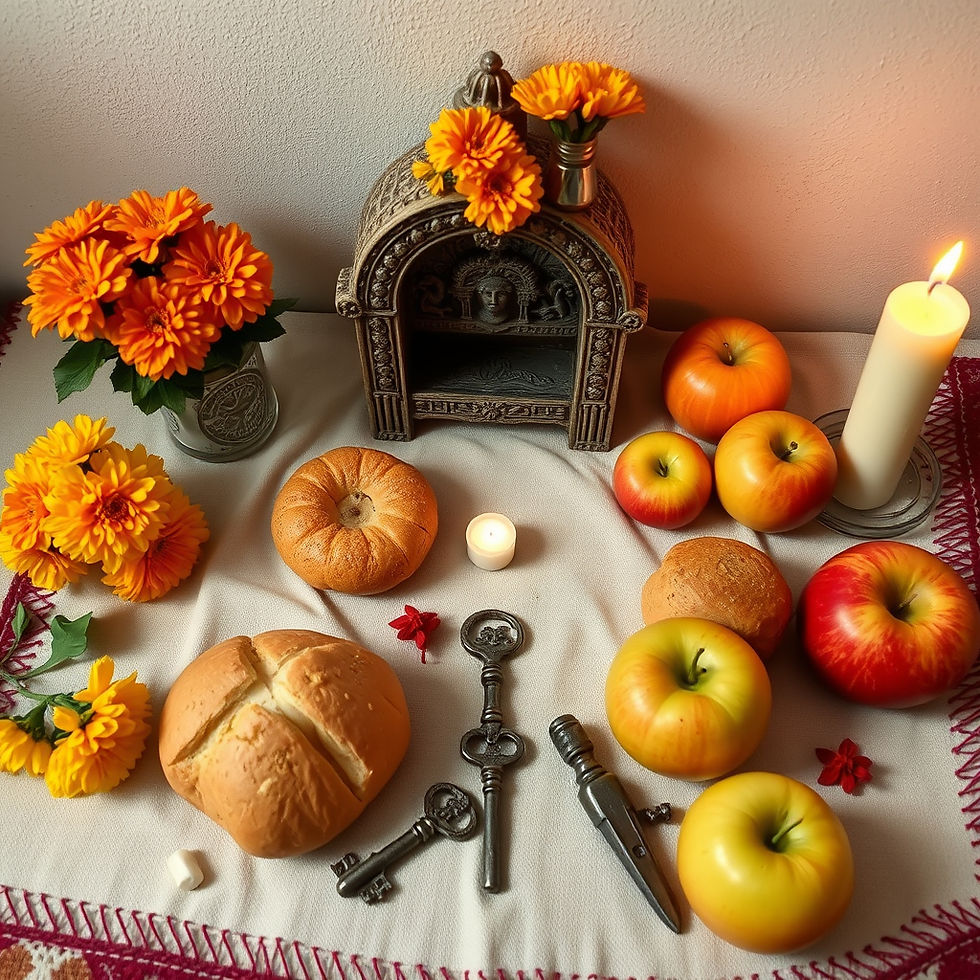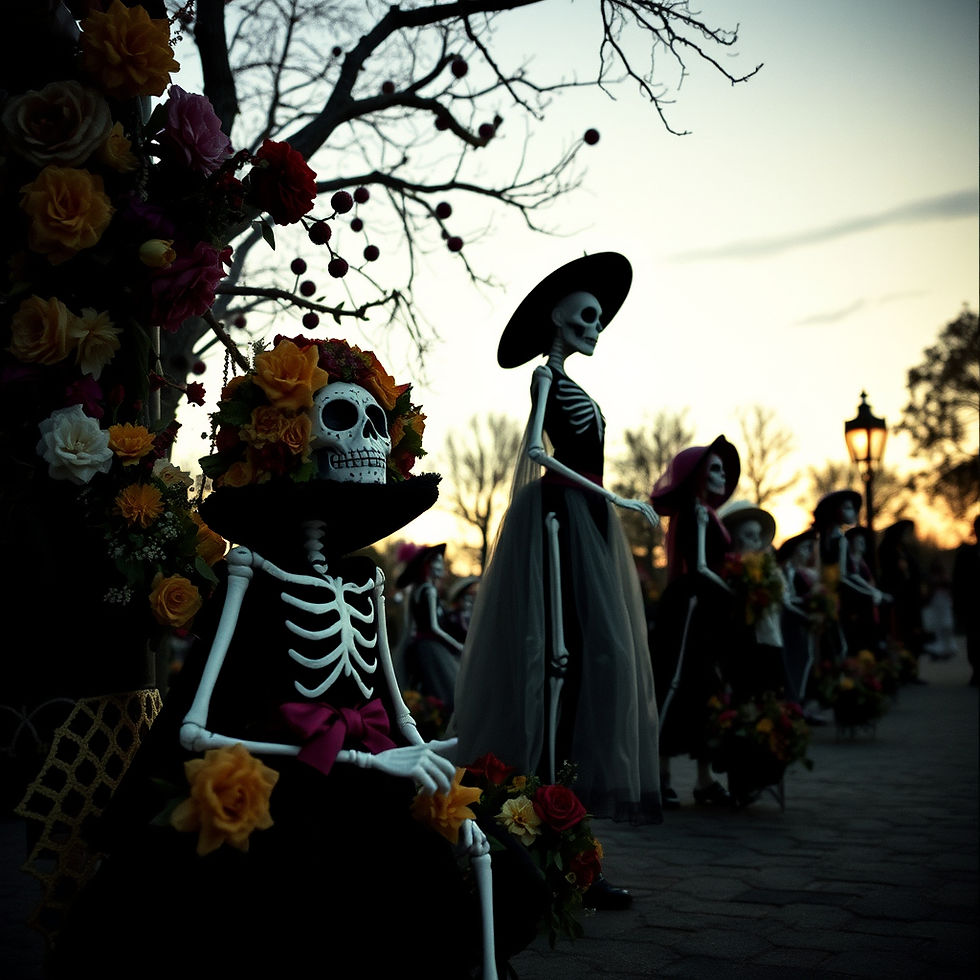Ancestor Veneration in Autumn’s Descent: Honoring Lineage in the Season of Shadows
- Scarly

- Oct 3
- 4 min read
As the wheel of the year turns toward autumn’s deepening shadows, the world slows. Trees release their leaves, harvests are gathered, and nights stretch longer with each passing day. This descent into the darker half of the year has always been seen as sacred. Across cultures, autumn is a time for remembering, honoring, and communing with ancestors, those who walked before and whose presence still lingers in the unseen.
Ancestor veneration is one of the most universal spiritual practices. Whether through formal ritual, simple offerings, or quiet remembrance, honoring the dead strengthens the bridge between worlds. In the threshold season, this practice becomes especially powerful, for the veil between the living and the departed grows thin.

The Autumnal Threshold
Autumn is not just the fading of light, it is the descent into a liminal state. Between the bustling vitality of summer and the stillness of winter lies a time of passage. This liminality opens gateways to ancestral realms, inviting reflection on cycles of life, death, and rebirth.
Festivals around the world mark this moment:
Samhain in Celtic lands, honoring ancestors and spirits as the old year closed.
Día de los Muertos in Mexico, welcoming beloved dead with altars, marigolds, and offerings.
All Souls’ Day in Christian tradition, remembering the faithful departed.
Though the forms differ, the essence remains the same, autumn invites us to look back with reverence and to understand that the past still flows within the present.
Why Honor Ancestors?
Ancestor veneration is more than remembrance; it is an act of relationship. The dead are not gone, they are transformed, living through memory, lineage, and spirit. To honor them is to acknowledge:
Continuity of Life: Every breath we take is tied to generations before.
Guidance and Wisdom: Ancestors often act as spirit allies, offering counsel, warnings, or support.
Healing of Lineage: Rituals of remembrance can bring peace to family lines, healing old wounds.
Rooted Identity: Honoring ancestors connects us to heritage, grounding us in culture and story.
In the season of descent, these connections grow stronger, reminding us that we are not alone as we walk into shadow.
Building an Ancestor Altar
One of the most direct ways to venerate ancestors is through an altar. This sacred space acts as both offering site and doorway between realms.
Steps to Create an Ancestor Altar:
Choose a Space: A small table, shelf, or windowsill works well.
Lay the Foundation: Cover with cloth in autumn tones, black, deep red, gold, or white.
Photographs and Symbols: Place images of ancestors, heirlooms, or symbols of heritage.
Offerings: Traditional offerings include bread, fruit, marigolds, candles, and drinks loved by the departed.
Lighting the Path: Candles or lanterns act as beacons, guiding spirits to the altar.
Personal Touch: Letters, poems, or objects of remembrance deepen the connection.
Altars need not be elaborate. Sincerity matters more than form. Even a single candle lit in remembrance can serve as a powerful act of veneration.
Ritual Practices for Autumn Ancestor Work
Daily Offerings: Pour a small libation of water, coffee, or alcohol at the altar each morning, inviting ancestors to share in daily life.
Prayer and Song: Speak aloud to them, share stories, or sing songs that connect to lineage.
Divination: Use tarot, runes, or other tools to ask ancestors for guidance during this liminal season.
Ancestral Meditation: Sit quietly, envision a line of ancestors behind you, and breathe in their strength, wisdom, and presence.
Storytelling Gatherings: Share family tales with loved ones. Speaking names aloud keeps their memory alive.
Symbols of the Season
Autumn is rich with natural symbols that carry ancestral resonance:
Marigolds (cempasúchil): Known as the “flower of the dead” in Mexico, believed to guide souls with their bright color and scent.
Apples and Bread: Offerings of sustenance that link the living to the departed.
Keys and Bones: Emblems of passage, unlocking the gates between realms.
Smoke and Incense: Carriers of prayer, rising to meet the unseen.
Integrating these symbols into ritual helps align practice with the seasonal current.

Healing Through Ancestral Connection
Not all ancestral relationships feel simple or easy. Some lineages carry pain, trauma, or estrangement. Yet even here, ancestor veneration offers healing. By acknowledging and working with those who came before, even imperfectly, cycles of harm can be seen, named, and released.
Some practitioners choose to honor only the “well ancestors,” those who are supportive and benevolent. Others engage in deeper shadow work, offering prayers for peace and healing to ancestors who struggled. Both paths are valid and can bring profound transformation.
Ancestors as Threshold Allies
In autumn’s descent, ancestors stand as guardians at the threshold. They remind us that endings are not absolute but cyclical, and that within death lies continuity. Their presence strengthens courage as nights grow long and helps carry wisdom across the liminal divide.
To walk with ancestors is to walk with memory, story, and legacy. It is to stand at the threshold of past and present, knowing that the future is built on the foundations they laid.
Closing Thoughts
Ancestor veneration during autumn is not a practice confined to the past; it is a living, breathing relationship. Each offering, prayer, or story creates threads that weave generations together. As the world darkens and the veil thins, these threads glow with the warmth of connection, guiding us through the season of shadows.
In honoring ancestors, we find not only remembrance but strength. Their footsteps echo in ours, and their presence reminds us: we are part of a continuum, never truly alone, always walking with those who came before.




Thank you! ✨🫶
Thank you so much for sharing this with us Scarly. ❤️💙